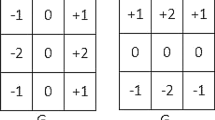Abstract
A highly efficient recursive algorithm for edge detection is presented. Using Canny's design [1], we show that a solution to his precise formulation of detection and localization for an infinite extent filter leads to an optimal operator in one dimension, which can be efficiently implemented by two recursive filters moving in opposite directions. In addition to the noise truncature immunity which results, the recursive nature of the filtering operations leads, with sequential machines, to a substantial saving in computational effort (five multiplications and five additions for one pixel, independent of the size of the neighborhood). The extension to the two-dimensional case is considered and the resulting filtering structures are implemented as two-dimensional recursive filters. Hence, the filter size can be varied by simply changing the value of one parameter without affecting the time execution of the algorithm. Performance measures of this new edge detector are given and compared to Canny's filters. Various experimental results are shown.
Similar content being viewed by others
Explore related subjects
Discover the latest articles, news and stories from top researchers in related subjects.References
J.F. Canny, “Finding edges and lines in images”, M.I.T. Artif. Intell. Lab., Cambridge, MA, TR-720, 1983.
L.S. Davis, “A survey of edge detection techniques”, COMPUT. GRAPHICS IMAGE PROCESSING vol. 4, pp. 248–270, 1975.
W.E.L. Grimson and E.C. Hildreth, Comments on “Digital step edges from zero crossings of second directional derivatives”, IEEE TRANS. PAMI, vol. PAMI-7, pp. 121–129, January 1985.
R.M. Haralick, “Digital step edges from zero crossings of second directional derivative”, IEEE TRANS. PAMI. vol. PAMI-6, pp. 58–68, January 1984.
Ellen C. Hildreth, “The detection of intensity changes by computer and biological vision systems”, COMPUT. VISION GRAPHICS IMAGE PROCESSING vol. 22, pp. 1–27, 1983.
A. Rosenfeld and A.C. Kak, DIGITAL PICTURE PROCESSING, 2nd edn., vol. 2. Academic Press: New York, 1982.
J.W. Modestino and R.W. Fries, “Edge detection in noisy images using recursive digital filtering”, COMPUT. GRAPHICS IMAGE PROCESSING vol. 6, pp. 409–433, 1977.
K.S. Shanmugan, F.M. Dickey, and J.A. Green, “An optimal frequency domain filter for edge detection in digital pictures”, IEEE TRANS. PAMI. vol. PAMI-1, pp. 37–49, 1979.
A. Witkin, “Scale-space filtering”, in PROC. 7TH INT. JOINT CONF. ARTIF. INTELL., Karlsrühe, FRG, 1983, pp. 1019–1021.
L.A. Spacek, “The detection of contours and their visual motion”, PhD dissertation, University of Essex at Colchester, December 1985.
R. Deriche, “Separable recursive filtering for efficient multi-scale edge detection”, in PROC. INT. WORKSHOP INDUSTRIAL APPLICATIONS MACH. VISION INTELL., Roppongi, Tokyo, 2–4 February 1987.
T. Poggio, H. Voorhees, and A. Yuille, “A regularized solution to edge detection”, M.I.T. Artif. Intell. Lab., Cambridge, MA, A.I. Memo. 833, May 1985.
L. R. Rabiner and B. Gold, THEORY AND APPLICATION OF DIGITAL SIGNAL PROCESSING. Prentice-Hall: Englewood Cliffs, NJ.
N.K. Bose, DIGITAL FILTERS: THEORY AND APPLICATIONS, Elsevier: New York.
J.B. Knowles and E.M. Olcayto, “Coefficient accuracy and digital filter response”, IEEE TRANS. CIRCUIT THEORY vol. CT-15, no. 1, March 1968.
Author information
Authors and Affiliations
Rights and permissions
About this article
Cite this article
Deriche, R. Using Canny's criteria to derive a recursively implemented optimal edge detector. Int J Comput Vision 1, 167–187 (1987). https://doi.org/10.1007/BF00123164
Issue Date:
DOI: https://doi.org/10.1007/BF00123164




